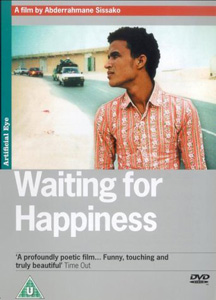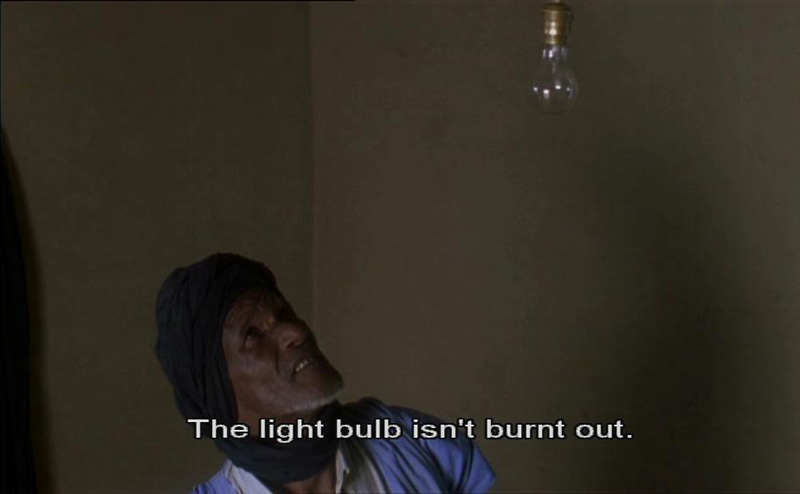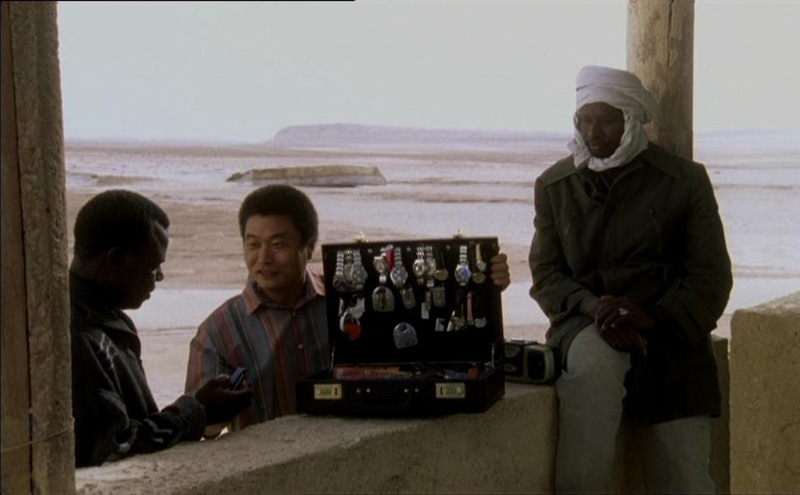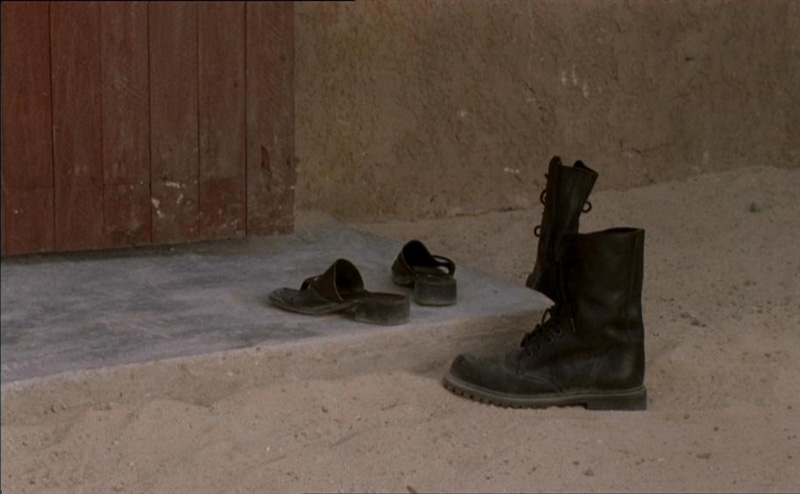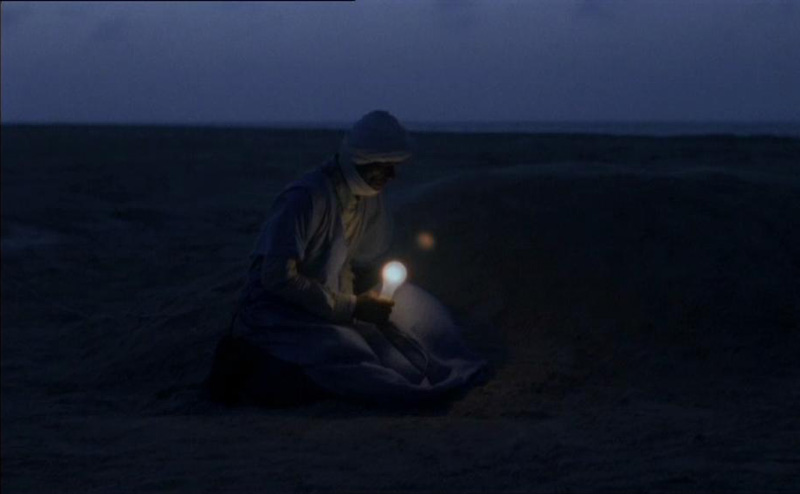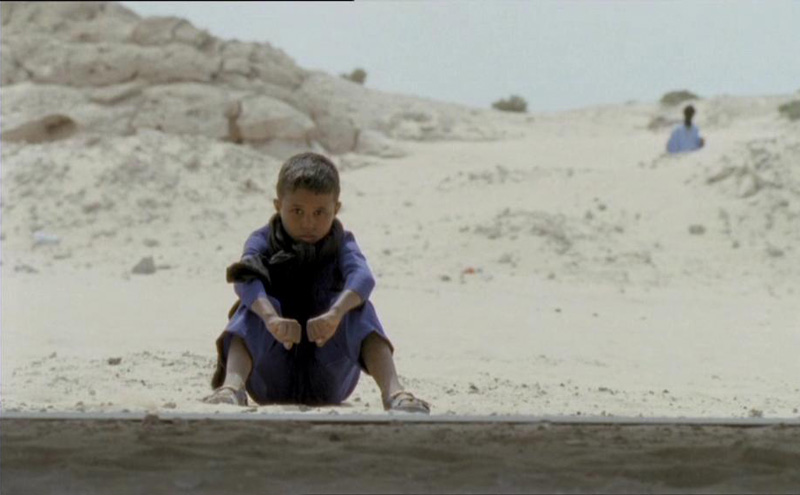![]()

![]()
(aka "Waiting for Happiness")
directed
by Abderrahmana Sissako
France / Mauritania 2002
One of the attracting and refreshing features of African
cinema, which also can be extended onto most world cinema, is, that it doesn’t
have to make up anything, but deals with issues important to both the natives
and in length of that to the nation. It may be religion, education or, as here
in “Waiting for Happiness”, cultural differences. It has often been pointed out,
that Iranic cinema deals with self reflection: This also is true for this
particular branch of African cinema, as Sissako himself points out: "Creation is
a search of oneself... And not only creation, but also all that one does."
On the edge of the desert lies a small coastal town. While it is as rural as can
be, its location allows it to serve as a transit town, for those traveling to
Europe. Here, Abdallah is visiting his mother become traveling to Europe.
Unfamiliar with local costume and the dialect, he is a stranger in a strange
land, that it self is estranged, as it on one side maintains local costumes and
on the other side tries to allow progress to enter. We are constantly introduced
to elements, which doesn’t seem to fit in: red sneakers, television, karaoke and
even something as simple as a children’s toy, while at the same time being shown
how tradition is taught from elders to the young.
Throughout “Waiting for Happiness”, Sissako sets up situations where people have
to talk to each other. It is curious, that in a film almost empty of dialogue,
the act of communication is one of the central themes. “The intention to
communicate is more important than communication itself. If somebody wants to
speak to me, it means I exist in their eyes.” says Sissako.
Sissako made “Waiting for Happiness” without any script and with non actors,
having taken characters already existing and put into the location, also already
existing. As he says: “It is all there for the camera to capture”. For Sissako
it is important that it is the images that tell the story, that with almost
poetic simplicity examinants the conflict between western progress and native
(Islamic) tradition – with a healthy portion of self irony and humour.
Winner of the both the FIPRESCI “Un Certain Regard” prize and the France Culture
Award in Cannes 2002, “Waiting for Happiness” is a rare gem of world cinema,
allowing pictures to convey situations. It is a demanding film, but as Tsai
Ming-Liang, a director very similar to Sissako, if one takes his time, one will
be rewarded.
![]() out of
out of
![]()
Theatrical Release: May 19th, 2002 (Cannes Film Festival)
Reviews More Reviews DVD Reviews
DVD Review: Artificial Eye - Region 2 - PAL
| DVD Box Cover |
|
CLICK to order from: NOTE: Purchases through DVDBeaver's links to Amazon help keep us afloat and advertisement free! |
| Distribution |
Artificial Eye Region 2 - PAL |
|
| Runtime | 1:31:27 | |
| Video |
1,61 Aspect Ratio
16X9 enhanced |
|
|
Bitrate:
NOTE: The Vertical axis represents the bits transferred per second. The Horizontal is the time in minutes. |
|
|
| Audio | Dolby Digital 2.0 | |
| Subtitles | English, None (16x9 friendly) | |
| Features |
Release Information: Studio: Artificial Eye Aspect Ratio:
Edition Details: Chapters 12 |
|
| Comments |
This is a nice presentation of
rare and valuable entry of cinema. It seems as if the presentation is 1.61
(16x9), but as my TV is overscanning, I am not sure. The picture looks great
and the sound is quiet detailed and "surround" for a 2.0 source. The interview is edited together from a longer interview, using fades to cut between "paragraphs". It is very informative and allows one to understand not only Sissako as an artist, but also allows one to understand the images. Language is French and the subtitles are burned. Also on the DVD is a rare gem: The 1997 short "October", which Sissako shot in Moscow. It is most likely 8mm black and white source (perhaps 16mm). The sound is monaural and the picture suffers from heavy ghosting and is also very grainy. However, it is a great little film, dealing with people in exile, and makes a nice contrast to "Waiting for Happiness" in both motif and themes. |
|
DVD Menus
|
|
|
|
|
|
|
|
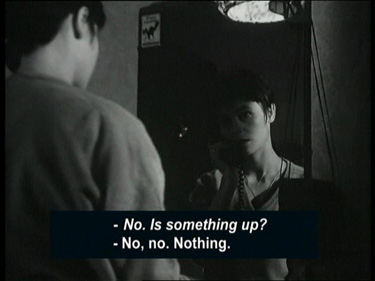 |
Subtitle Sample
|
|
Screen Captures
|
|
|
|
|
|
|
|
|
|
|
|
![]()

![]()
DONATIONS Keep DVDBeaver alive:
Mail cheques, money orders, cash to: or CLICK PayPal logo to donate!
|
Gary Tooze
|
|
